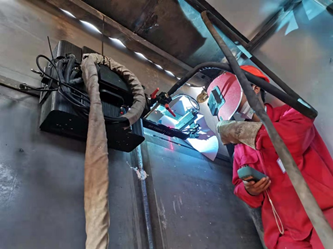Detailed introduction to the application significance of welding robots
Date:2021-10-20 Views:781
The reason why welding robots can account for over 40% of the total number of industrial robots is related to the special industry of welding. Welding, as an industrial "tailor", is a very important processing method in industrial production. At the same time, due to the presence of welding smoke, arc light, and metal spatter, the working environment of welding is also very harsh.

The quality of welding has a decisive impact on product quality. To sum up, using welding robots has the following main significance: stabilizing and improving welding quality, ensuring its uniformity. Welding parameters such as welding current, voltage, welding speed, and welding elongation play a decisive role in the welding results.
When using robot welding, the welding parameters for each weld seam are constant, and the quality of the weld seam is less affected by human factors, reducing the requirements for workers' operating skills. Therefore, the welding quality is stable. During manual welding, the welding speed, dry elongation, and other factors are variable, making it difficult to achieve uniformity of quality.
Improved working conditions for workers. The use of robot welding workers is only for loading and unloading workpieces, away from welding arcs, smoke, and splashes. For spot welding, workers no longer carry bulky manual welding tongs, freeing them from heavy physical labor. Improve labor productivity. Robots have no fatigue and can produce continuously 24 hours a day. In addition, with the application of high-speed and efficient welding technology, the use of robots for welding has significantly improved efficiency.
The reason why welding robots can account for over 40% of the total number of industrial robots is related to the special industry of welding. Welding, as an industrial "tailor", is a very important processing method in industrial production. At the same time, due to the presence of welding smoke, arc light, and metal spatter, the working environment of welding is also very harsh.

The quality of welding has a decisive impact on product quality. To sum up, using welding robots has the following main significance: stabilizing and improving welding quality, ensuring its uniformity. Welding parameters such as welding current, voltage, welding speed, and welding elongation play a decisive role in the welding results.
When using robot welding, the welding parameters for each weld seam are constant, and the quality of the weld seam is less affected by human factors, reducing the requirements for workers' operating skills. Therefore, the welding quality is stable. During manual welding, the welding speed, dry elongation, and other factors are variable, making it difficult to achieve uniformity of quality.
Improved working conditions for workers. The use of robot welding workers is only for loading and unloading workpieces, away from welding arcs, smoke, and splashes. For spot welding, workers no longer carry bulky manual welding tongs, freeing them from heavy physical labor. Improve labor productivity. Robots have no fatigue and can produce continuously 24 hours a day. In addition, with the application of high-speed and efficient welding technology, the use of robots for welding has significantly improved efficiency.











